AC5003 - Examining Technical Analysis and Efficient Market Hypothesis
VerifiedAdded on 2023/04/22
|9
|2590
|141
Essay
AI Summary
This essay critically examines the statement that technical analysis can generate statistically significant profits despite its incompatibility with the Efficient Market Hypothesis (EMH). It explores the principles of technical analysis, which involves predicting future stock price movements based on historical data and patterns, and contrasts it with the EMH, which posits that current stock prices reflect all available information, making it impossible to consistently achieve abnormal profits through technical analysis. The essay further discusses different forms of market efficiency (strong, semi-strong, and weak) and their implications for the effectiveness of technical and fundamental analysis. It also addresses the role of support and resistance levels, trend lines, and various chart patterns used in technical analysis. The essay concludes by highlighting the potential for technical analysis to identify trends and patterns, despite the challenges posed by market efficiency, and suggests that incorporating both rational and irrational factors can improve trading outcomes. Desklib offers a wealth of study resources, including past papers and solved assignments, to support students in their academic endeavors.

Running head: FINANCE
FINANCE
Name of the Student:
Name of the University:
Author’s Note:
FINANCE
Name of the Student:
Name of the University:
Author’s Note:
Paraphrase This Document
Need a fresh take? Get an instant paraphrase of this document with our AI Paraphraser
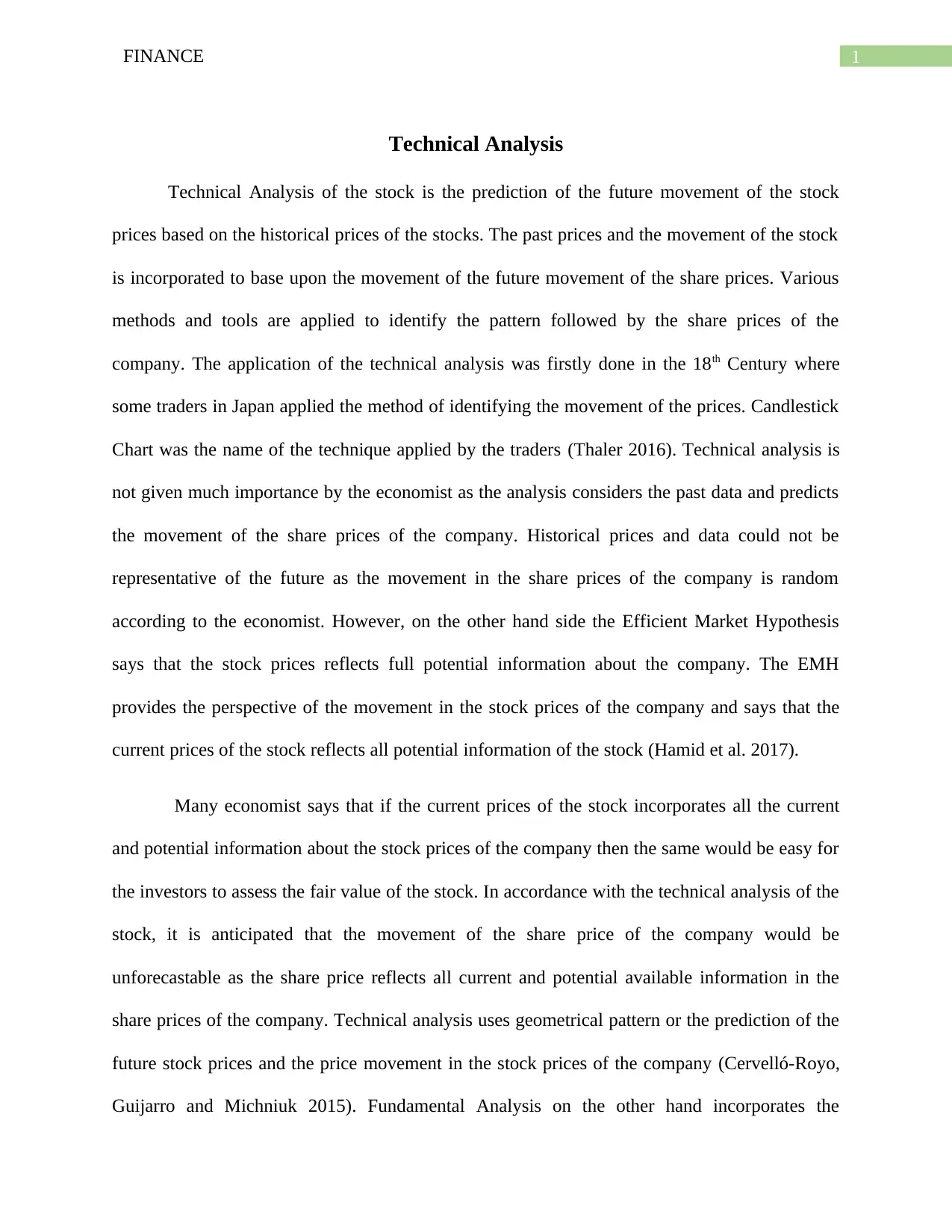
1FINANCE
Technical Analysis
Technical Analysis of the stock is the prediction of the future movement of the stock
prices based on the historical prices of the stocks. The past prices and the movement of the stock
is incorporated to base upon the movement of the future movement of the share prices. Various
methods and tools are applied to identify the pattern followed by the share prices of the
company. The application of the technical analysis was firstly done in the 18th Century where
some traders in Japan applied the method of identifying the movement of the prices. Candlestick
Chart was the name of the technique applied by the traders (Thaler 2016). Technical analysis is
not given much importance by the economist as the analysis considers the past data and predicts
the movement of the share prices of the company. Historical prices and data could not be
representative of the future as the movement in the share prices of the company is random
according to the economist. However, on the other hand side the Efficient Market Hypothesis
says that the stock prices reflects full potential information about the company. The EMH
provides the perspective of the movement in the stock prices of the company and says that the
current prices of the stock reflects all potential information of the stock (Hamid et al. 2017).
Many economist says that if the current prices of the stock incorporates all the current
and potential information about the stock prices of the company then the same would be easy for
the investors to assess the fair value of the stock. In accordance with the technical analysis of the
stock, it is anticipated that the movement of the share price of the company would be
unforecastable as the share price reflects all current and potential available information in the
share prices of the company. Technical analysis uses geometrical pattern or the prediction of the
future stock prices and the price movement in the stock prices of the company (Cervelló-Royo,
Guijarro and Michniuk 2015). Fundamental Analysis on the other hand incorporates the
Technical Analysis
Technical Analysis of the stock is the prediction of the future movement of the stock
prices based on the historical prices of the stocks. The past prices and the movement of the stock
is incorporated to base upon the movement of the future movement of the share prices. Various
methods and tools are applied to identify the pattern followed by the share prices of the
company. The application of the technical analysis was firstly done in the 18th Century where
some traders in Japan applied the method of identifying the movement of the prices. Candlestick
Chart was the name of the technique applied by the traders (Thaler 2016). Technical analysis is
not given much importance by the economist as the analysis considers the past data and predicts
the movement of the share prices of the company. Historical prices and data could not be
representative of the future as the movement in the share prices of the company is random
according to the economist. However, on the other hand side the Efficient Market Hypothesis
says that the stock prices reflects full potential information about the company. The EMH
provides the perspective of the movement in the stock prices of the company and says that the
current prices of the stock reflects all potential information of the stock (Hamid et al. 2017).
Many economist says that if the current prices of the stock incorporates all the current
and potential information about the stock prices of the company then the same would be easy for
the investors to assess the fair value of the stock. In accordance with the technical analysis of the
stock, it is anticipated that the movement of the share price of the company would be
unforecastable as the share price reflects all current and potential available information in the
share prices of the company. Technical analysis uses geometrical pattern or the prediction of the
future stock prices and the price movement in the stock prices of the company (Cervelló-Royo,
Guijarro and Michniuk 2015). Fundamental Analysis on the other hand incorporates the
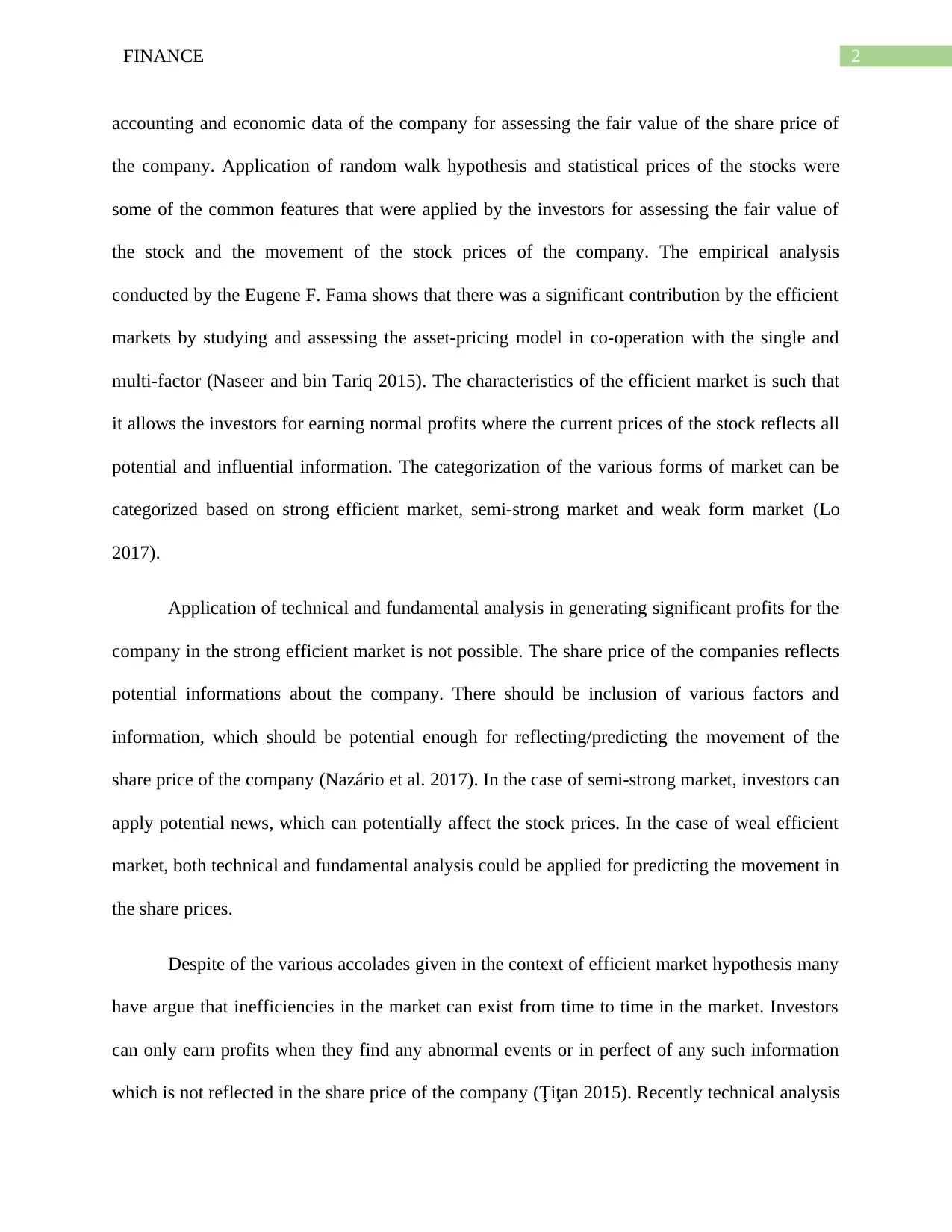
2FINANCE
accounting and economic data of the company for assessing the fair value of the share price of
the company. Application of random walk hypothesis and statistical prices of the stocks were
some of the common features that were applied by the investors for assessing the fair value of
the stock and the movement of the stock prices of the company. The empirical analysis
conducted by the Eugene F. Fama shows that there was a significant contribution by the efficient
markets by studying and assessing the asset-pricing model in co-operation with the single and
multi-factor (Naseer and bin Tariq 2015). The characteristics of the efficient market is such that
it allows the investors for earning normal profits where the current prices of the stock reflects all
potential and influential information. The categorization of the various forms of market can be
categorized based on strong efficient market, semi-strong market and weak form market (Lo
2017).
Application of technical and fundamental analysis in generating significant profits for the
company in the strong efficient market is not possible. The share price of the companies reflects
potential informations about the company. There should be inclusion of various factors and
information, which should be potential enough for reflecting/predicting the movement of the
share price of the company (Nazário et al. 2017). In the case of semi-strong market, investors can
apply potential news, which can potentially affect the stock prices. In the case of weal efficient
market, both technical and fundamental analysis could be applied for predicting the movement in
the share prices.
Despite of the various accolades given in the context of efficient market hypothesis many
have argue that inefficiencies in the market can exist from time to time in the market. Investors
can only earn profits when they find any abnormal events or in perfect of any such information
which is not reflected in the share price of the company (Ţiţan 2015). Recently technical analysis
accounting and economic data of the company for assessing the fair value of the share price of
the company. Application of random walk hypothesis and statistical prices of the stocks were
some of the common features that were applied by the investors for assessing the fair value of
the stock and the movement of the stock prices of the company. The empirical analysis
conducted by the Eugene F. Fama shows that there was a significant contribution by the efficient
markets by studying and assessing the asset-pricing model in co-operation with the single and
multi-factor (Naseer and bin Tariq 2015). The characteristics of the efficient market is such that
it allows the investors for earning normal profits where the current prices of the stock reflects all
potential and influential information. The categorization of the various forms of market can be
categorized based on strong efficient market, semi-strong market and weak form market (Lo
2017).
Application of technical and fundamental analysis in generating significant profits for the
company in the strong efficient market is not possible. The share price of the companies reflects
potential informations about the company. There should be inclusion of various factors and
information, which should be potential enough for reflecting/predicting the movement of the
share price of the company (Nazário et al. 2017). In the case of semi-strong market, investors can
apply potential news, which can potentially affect the stock prices. In the case of weal efficient
market, both technical and fundamental analysis could be applied for predicting the movement in
the share prices.
Despite of the various accolades given in the context of efficient market hypothesis many
have argue that inefficiencies in the market can exist from time to time in the market. Investors
can only earn profits when they find any abnormal events or in perfect of any such information
which is not reflected in the share price of the company (Ţiţan 2015). Recently technical analysis
⊘ This is a preview!⊘
Do you want full access?
Subscribe today to unlock all pages.

Trusted by 1+ million students worldwide
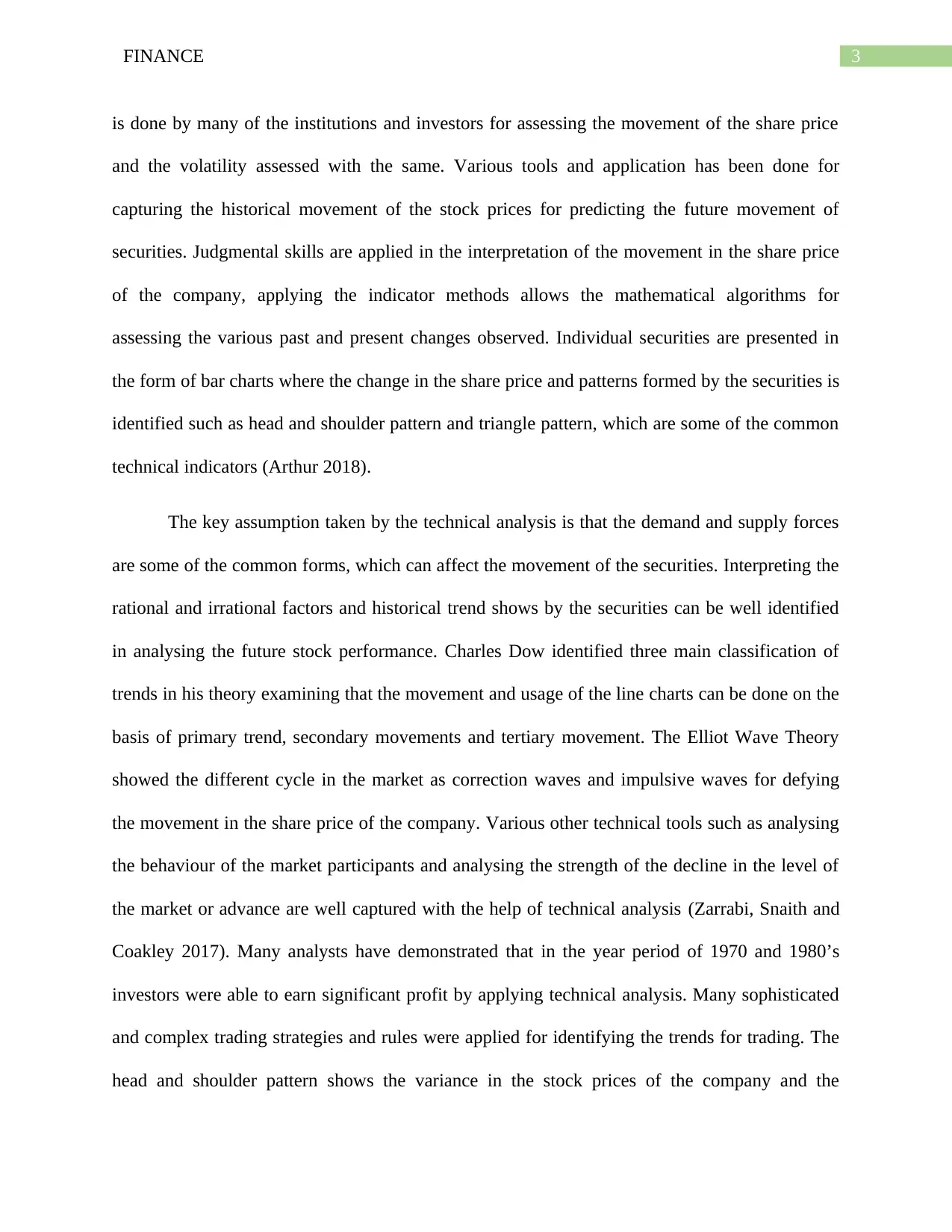
3FINANCE
is done by many of the institutions and investors for assessing the movement of the share price
and the volatility assessed with the same. Various tools and application has been done for
capturing the historical movement of the stock prices for predicting the future movement of
securities. Judgmental skills are applied in the interpretation of the movement in the share price
of the company, applying the indicator methods allows the mathematical algorithms for
assessing the various past and present changes observed. Individual securities are presented in
the form of bar charts where the change in the share price and patterns formed by the securities is
identified such as head and shoulder pattern and triangle pattern, which are some of the common
technical indicators (Arthur 2018).
The key assumption taken by the technical analysis is that the demand and supply forces
are some of the common forms, which can affect the movement of the securities. Interpreting the
rational and irrational factors and historical trend shows by the securities can be well identified
in analysing the future stock performance. Charles Dow identified three main classification of
trends in his theory examining that the movement and usage of the line charts can be done on the
basis of primary trend, secondary movements and tertiary movement. The Elliot Wave Theory
showed the different cycle in the market as correction waves and impulsive waves for defying
the movement in the share price of the company. Various other technical tools such as analysing
the behaviour of the market participants and analysing the strength of the decline in the level of
the market or advance are well captured with the help of technical analysis (Zarrabi, Snaith and
Coakley 2017). Many analysts have demonstrated that in the year period of 1970 and 1980’s
investors were able to earn significant profit by applying technical analysis. Many sophisticated
and complex trading strategies and rules were applied for identifying the trends for trading. The
head and shoulder pattern shows the variance in the stock prices of the company and the
is done by many of the institutions and investors for assessing the movement of the share price
and the volatility assessed with the same. Various tools and application has been done for
capturing the historical movement of the stock prices for predicting the future movement of
securities. Judgmental skills are applied in the interpretation of the movement in the share price
of the company, applying the indicator methods allows the mathematical algorithms for
assessing the various past and present changes observed. Individual securities are presented in
the form of bar charts where the change in the share price and patterns formed by the securities is
identified such as head and shoulder pattern and triangle pattern, which are some of the common
technical indicators (Arthur 2018).
The key assumption taken by the technical analysis is that the demand and supply forces
are some of the common forms, which can affect the movement of the securities. Interpreting the
rational and irrational factors and historical trend shows by the securities can be well identified
in analysing the future stock performance. Charles Dow identified three main classification of
trends in his theory examining that the movement and usage of the line charts can be done on the
basis of primary trend, secondary movements and tertiary movement. The Elliot Wave Theory
showed the different cycle in the market as correction waves and impulsive waves for defying
the movement in the share price of the company. Various other technical tools such as analysing
the behaviour of the market participants and analysing the strength of the decline in the level of
the market or advance are well captured with the help of technical analysis (Zarrabi, Snaith and
Coakley 2017). Many analysts have demonstrated that in the year period of 1970 and 1980’s
investors were able to earn significant profit by applying technical analysis. Many sophisticated
and complex trading strategies and rules were applied for identifying the trends for trading. The
head and shoulder pattern shows the variance in the stock prices of the company and the
Paraphrase This Document
Need a fresh take? Get an instant paraphrase of this document with our AI Paraphraser
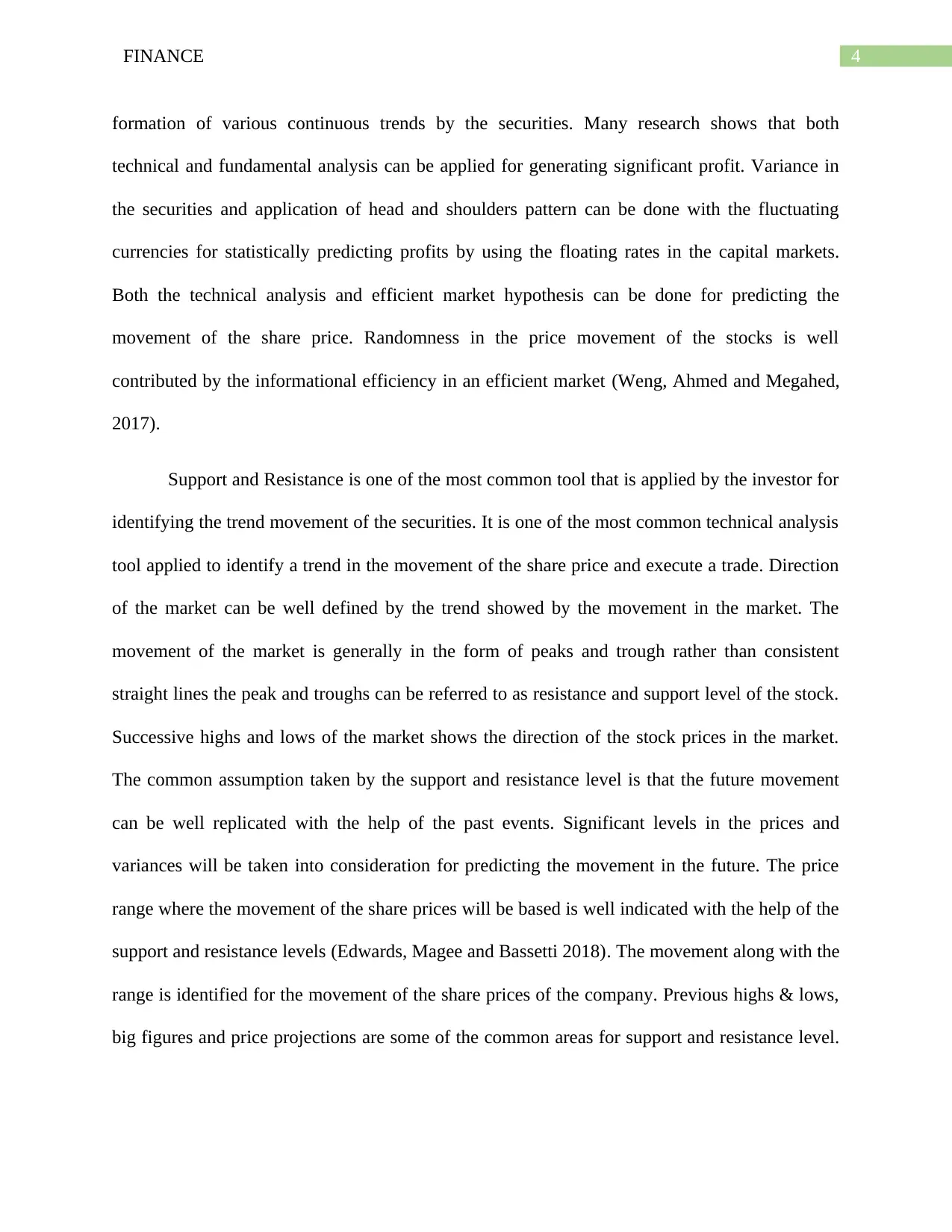
4FINANCE
formation of various continuous trends by the securities. Many research shows that both
technical and fundamental analysis can be applied for generating significant profit. Variance in
the securities and application of head and shoulders pattern can be done with the fluctuating
currencies for statistically predicting profits by using the floating rates in the capital markets.
Both the technical analysis and efficient market hypothesis can be done for predicting the
movement of the share price. Randomness in the price movement of the stocks is well
contributed by the informational efficiency in an efficient market (Weng, Ahmed and Megahed,
2017).
Support and Resistance is one of the most common tool that is applied by the investor for
identifying the trend movement of the securities. It is one of the most common technical analysis
tool applied to identify a trend in the movement of the share price and execute a trade. Direction
of the market can be well defined by the trend showed by the movement in the market. The
movement of the market is generally in the form of peaks and trough rather than consistent
straight lines the peak and troughs can be referred to as resistance and support level of the stock.
Successive highs and lows of the market shows the direction of the stock prices in the market.
The common assumption taken by the support and resistance level is that the future movement
can be well replicated with the help of the past events. Significant levels in the prices and
variances will be taken into consideration for predicting the movement in the future. The price
range where the movement of the share prices will be based is well indicated with the help of the
support and resistance levels (Edwards, Magee and Bassetti 2018). The movement along with the
range is identified for the movement of the share prices of the company. Previous highs & lows,
big figures and price projections are some of the common areas for support and resistance level.
formation of various continuous trends by the securities. Many research shows that both
technical and fundamental analysis can be applied for generating significant profit. Variance in
the securities and application of head and shoulders pattern can be done with the fluctuating
currencies for statistically predicting profits by using the floating rates in the capital markets.
Both the technical analysis and efficient market hypothesis can be done for predicting the
movement of the share price. Randomness in the price movement of the stocks is well
contributed by the informational efficiency in an efficient market (Weng, Ahmed and Megahed,
2017).
Support and Resistance is one of the most common tool that is applied by the investor for
identifying the trend movement of the securities. It is one of the most common technical analysis
tool applied to identify a trend in the movement of the share price and execute a trade. Direction
of the market can be well defined by the trend showed by the movement in the market. The
movement of the market is generally in the form of peaks and trough rather than consistent
straight lines the peak and troughs can be referred to as resistance and support level of the stock.
Successive highs and lows of the market shows the direction of the stock prices in the market.
The common assumption taken by the support and resistance level is that the future movement
can be well replicated with the help of the past events. Significant levels in the prices and
variances will be taken into consideration for predicting the movement in the future. The price
range where the movement of the share prices will be based is well indicated with the help of the
support and resistance levels (Edwards, Magee and Bassetti 2018). The movement along with the
range is identified for the movement of the share prices of the company. Previous highs & lows,
big figures and price projections are some of the common areas for support and resistance level.
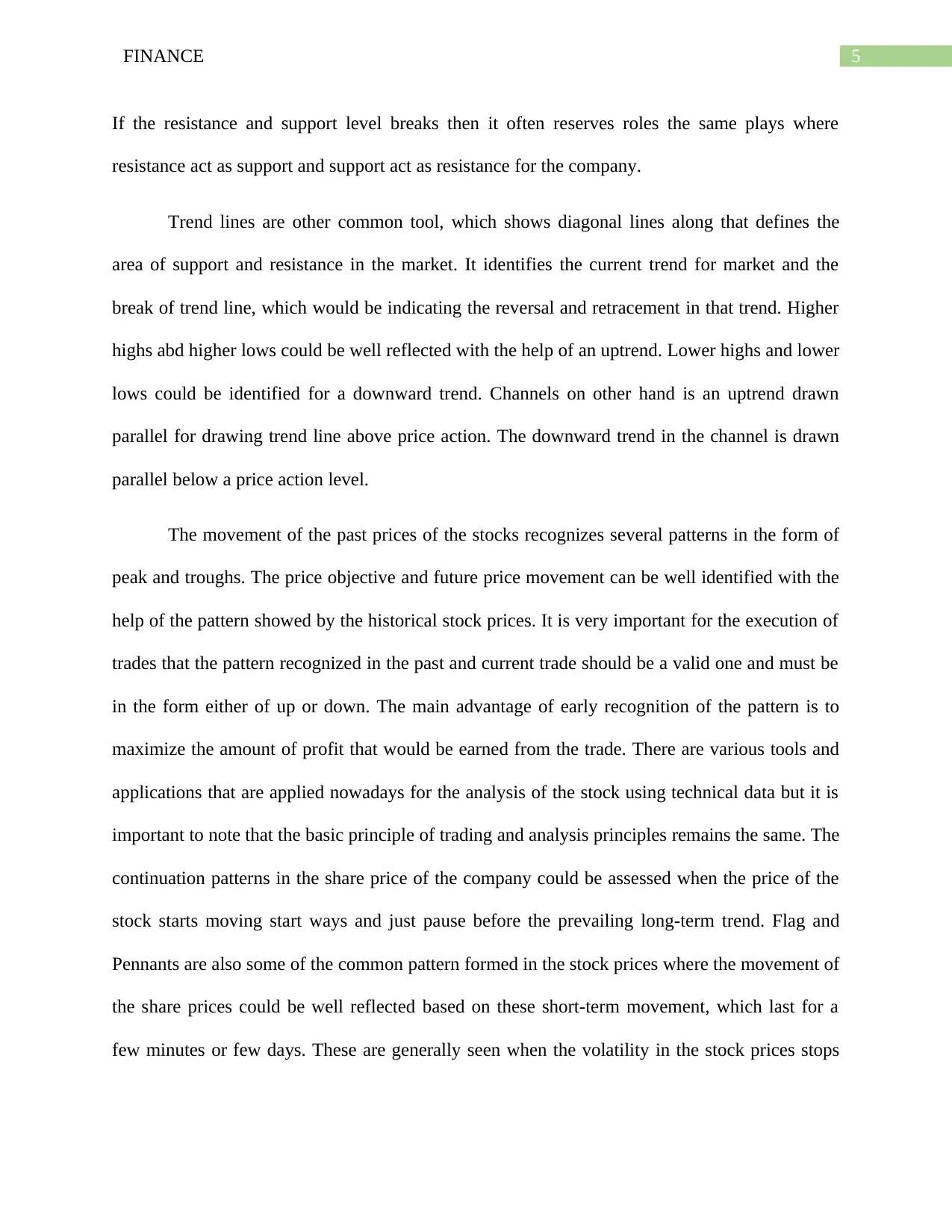
5FINANCE
If the resistance and support level breaks then it often reserves roles the same plays where
resistance act as support and support act as resistance for the company.
Trend lines are other common tool, which shows diagonal lines along that defines the
area of support and resistance in the market. It identifies the current trend for market and the
break of trend line, which would be indicating the reversal and retracement in that trend. Higher
highs abd higher lows could be well reflected with the help of an uptrend. Lower highs and lower
lows could be identified for a downward trend. Channels on other hand is an uptrend drawn
parallel for drawing trend line above price action. The downward trend in the channel is drawn
parallel below a price action level.
The movement of the past prices of the stocks recognizes several patterns in the form of
peak and troughs. The price objective and future price movement can be well identified with the
help of the pattern showed by the historical stock prices. It is very important for the execution of
trades that the pattern recognized in the past and current trade should be a valid one and must be
in the form either of up or down. The main advantage of early recognition of the pattern is to
maximize the amount of profit that would be earned from the trade. There are various tools and
applications that are applied nowadays for the analysis of the stock using technical data but it is
important to note that the basic principle of trading and analysis principles remains the same. The
continuation patterns in the share price of the company could be assessed when the price of the
stock starts moving start ways and just pause before the prevailing long-term trend. Flag and
Pennants are also some of the common pattern formed in the stock prices where the movement of
the share prices could be well reflected based on these short-term movement, which last for a
few minutes or few days. These are generally seen when the volatility in the stock prices stops
If the resistance and support level breaks then it often reserves roles the same plays where
resistance act as support and support act as resistance for the company.
Trend lines are other common tool, which shows diagonal lines along that defines the
area of support and resistance in the market. It identifies the current trend for market and the
break of trend line, which would be indicating the reversal and retracement in that trend. Higher
highs abd higher lows could be well reflected with the help of an uptrend. Lower highs and lower
lows could be identified for a downward trend. Channels on other hand is an uptrend drawn
parallel for drawing trend line above price action. The downward trend in the channel is drawn
parallel below a price action level.
The movement of the past prices of the stocks recognizes several patterns in the form of
peak and troughs. The price objective and future price movement can be well identified with the
help of the pattern showed by the historical stock prices. It is very important for the execution of
trades that the pattern recognized in the past and current trade should be a valid one and must be
in the form either of up or down. The main advantage of early recognition of the pattern is to
maximize the amount of profit that would be earned from the trade. There are various tools and
applications that are applied nowadays for the analysis of the stock using technical data but it is
important to note that the basic principle of trading and analysis principles remains the same. The
continuation patterns in the share price of the company could be assessed when the price of the
stock starts moving start ways and just pause before the prevailing long-term trend. Flag and
Pennants are also some of the common pattern formed in the stock prices where the movement of
the share prices could be well reflected based on these short-term movement, which last for a
few minutes or few days. These are generally seen when the volatility in the stock prices stops
⊘ This is a preview!⊘
Do you want full access?
Subscribe today to unlock all pages.

Trusted by 1+ million students worldwide
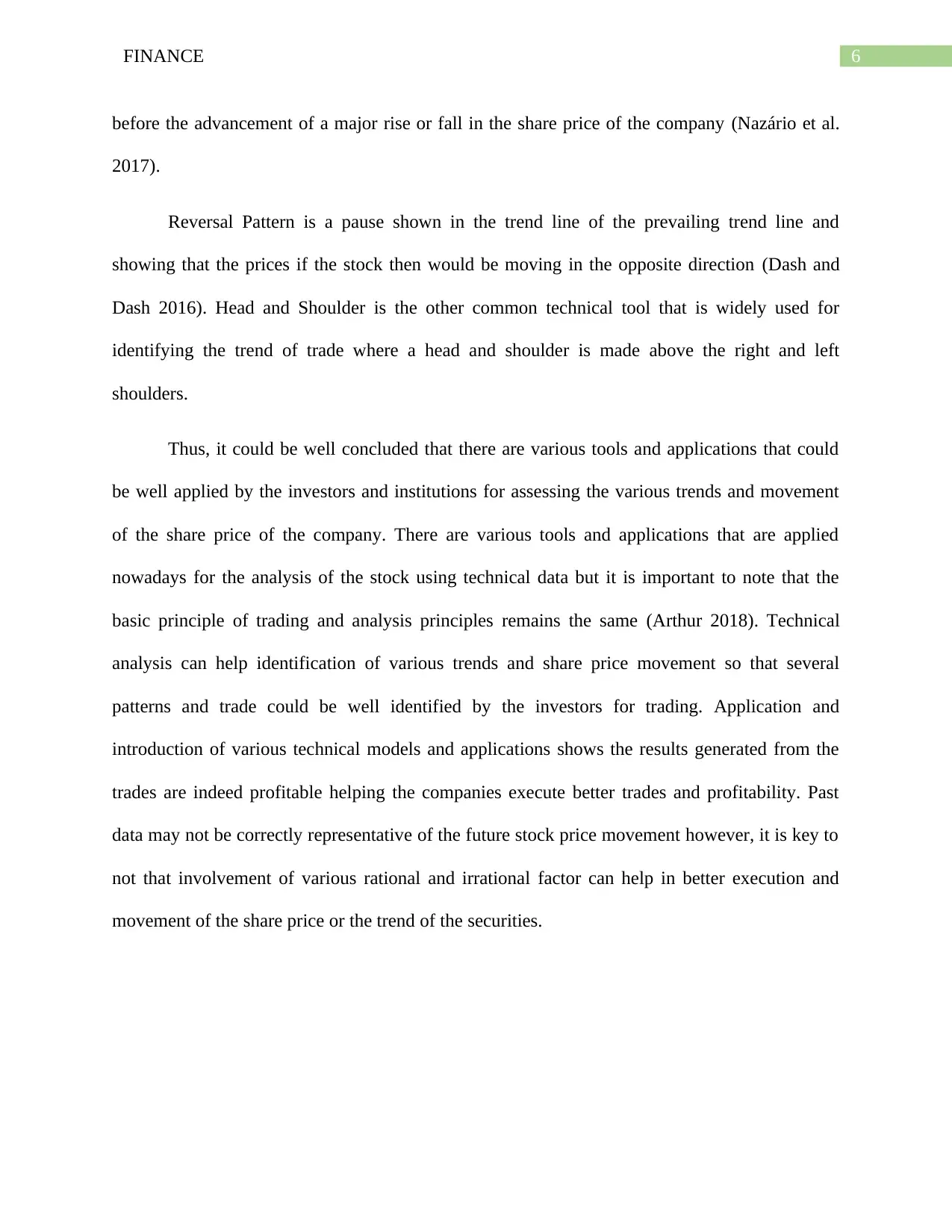
6FINANCE
before the advancement of a major rise or fall in the share price of the company (Nazário et al.
2017).
Reversal Pattern is a pause shown in the trend line of the prevailing trend line and
showing that the prices if the stock then would be moving in the opposite direction (Dash and
Dash 2016). Head and Shoulder is the other common technical tool that is widely used for
identifying the trend of trade where a head and shoulder is made above the right and left
shoulders.
Thus, it could be well concluded that there are various tools and applications that could
be well applied by the investors and institutions for assessing the various trends and movement
of the share price of the company. There are various tools and applications that are applied
nowadays for the analysis of the stock using technical data but it is important to note that the
basic principle of trading and analysis principles remains the same (Arthur 2018). Technical
analysis can help identification of various trends and share price movement so that several
patterns and trade could be well identified by the investors for trading. Application and
introduction of various technical models and applications shows the results generated from the
trades are indeed profitable helping the companies execute better trades and profitability. Past
data may not be correctly representative of the future stock price movement however, it is key to
not that involvement of various rational and irrational factor can help in better execution and
movement of the share price or the trend of the securities.
before the advancement of a major rise or fall in the share price of the company (Nazário et al.
2017).
Reversal Pattern is a pause shown in the trend line of the prevailing trend line and
showing that the prices if the stock then would be moving in the opposite direction (Dash and
Dash 2016). Head and Shoulder is the other common technical tool that is widely used for
identifying the trend of trade where a head and shoulder is made above the right and left
shoulders.
Thus, it could be well concluded that there are various tools and applications that could
be well applied by the investors and institutions for assessing the various trends and movement
of the share price of the company. There are various tools and applications that are applied
nowadays for the analysis of the stock using technical data but it is important to note that the
basic principle of trading and analysis principles remains the same (Arthur 2018). Technical
analysis can help identification of various trends and share price movement so that several
patterns and trade could be well identified by the investors for trading. Application and
introduction of various technical models and applications shows the results generated from the
trades are indeed profitable helping the companies execute better trades and profitability. Past
data may not be correctly representative of the future stock price movement however, it is key to
not that involvement of various rational and irrational factor can help in better execution and
movement of the share price or the trend of the securities.
Paraphrase This Document
Need a fresh take? Get an instant paraphrase of this document with our AI Paraphraser
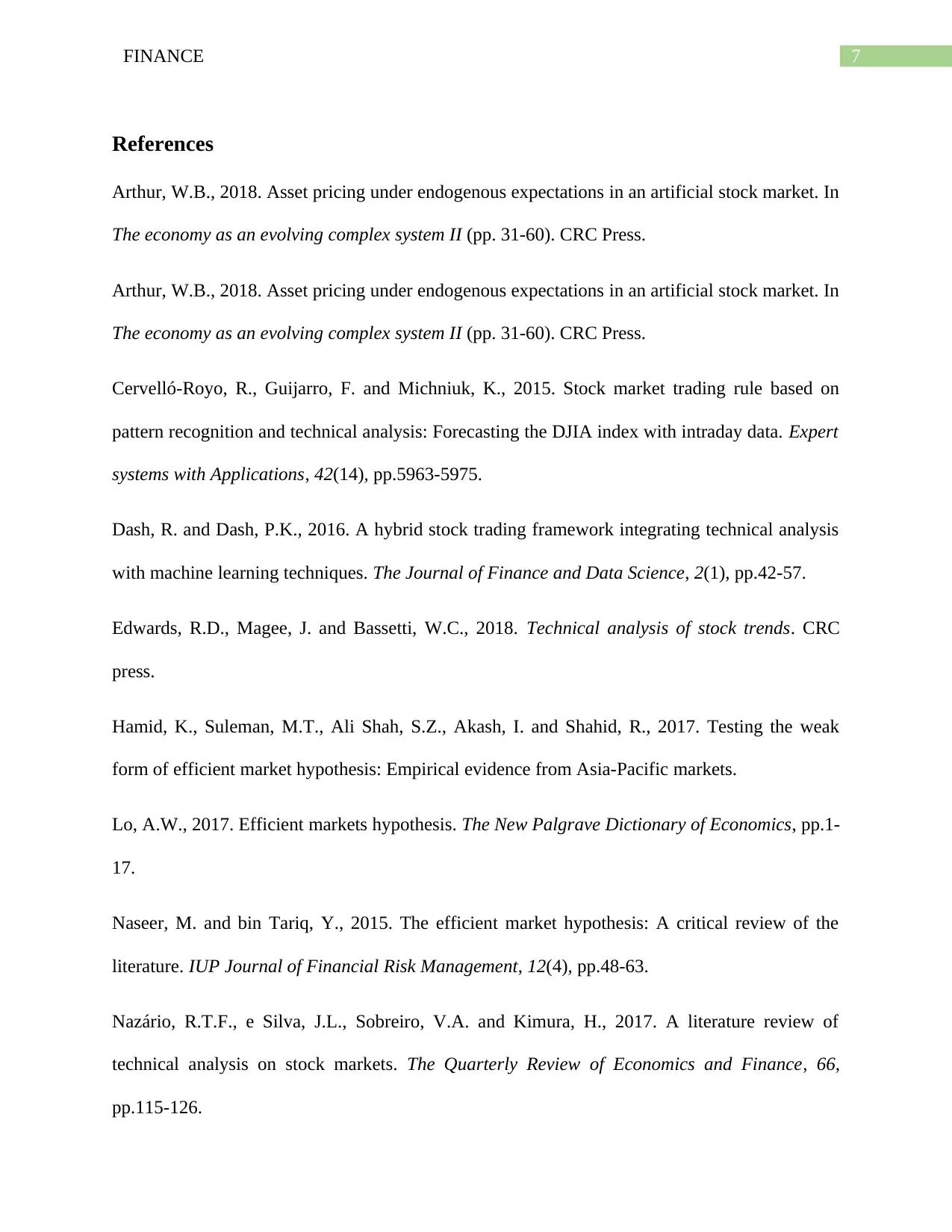
7FINANCE
References
Arthur, W.B., 2018. Asset pricing under endogenous expectations in an artificial stock market. In
The economy as an evolving complex system II (pp. 31-60). CRC Press.
Arthur, W.B., 2018. Asset pricing under endogenous expectations in an artificial stock market. In
The economy as an evolving complex system II (pp. 31-60). CRC Press.
Cervelló-Royo, R., Guijarro, F. and Michniuk, K., 2015. Stock market trading rule based on
pattern recognition and technical analysis: Forecasting the DJIA index with intraday data. Expert
systems with Applications, 42(14), pp.5963-5975.
Dash, R. and Dash, P.K., 2016. A hybrid stock trading framework integrating technical analysis
with machine learning techniques. The Journal of Finance and Data Science, 2(1), pp.42-57.
Edwards, R.D., Magee, J. and Bassetti, W.C., 2018. Technical analysis of stock trends. CRC
press.
Hamid, K., Suleman, M.T., Ali Shah, S.Z., Akash, I. and Shahid, R., 2017. Testing the weak
form of efficient market hypothesis: Empirical evidence from Asia-Pacific markets.
Lo, A.W., 2017. Efficient markets hypothesis. The New Palgrave Dictionary of Economics, pp.1-
17.
Naseer, M. and bin Tariq, Y., 2015. The efficient market hypothesis: A critical review of the
literature. IUP Journal of Financial Risk Management, 12(4), pp.48-63.
Nazário, R.T.F., e Silva, J.L., Sobreiro, V.A. and Kimura, H., 2017. A literature review of
technical analysis on stock markets. The Quarterly Review of Economics and Finance, 66,
pp.115-126.
References
Arthur, W.B., 2018. Asset pricing under endogenous expectations in an artificial stock market. In
The economy as an evolving complex system II (pp. 31-60). CRC Press.
Arthur, W.B., 2018. Asset pricing under endogenous expectations in an artificial stock market. In
The economy as an evolving complex system II (pp. 31-60). CRC Press.
Cervelló-Royo, R., Guijarro, F. and Michniuk, K., 2015. Stock market trading rule based on
pattern recognition and technical analysis: Forecasting the DJIA index with intraday data. Expert
systems with Applications, 42(14), pp.5963-5975.
Dash, R. and Dash, P.K., 2016. A hybrid stock trading framework integrating technical analysis
with machine learning techniques. The Journal of Finance and Data Science, 2(1), pp.42-57.
Edwards, R.D., Magee, J. and Bassetti, W.C., 2018. Technical analysis of stock trends. CRC
press.
Hamid, K., Suleman, M.T., Ali Shah, S.Z., Akash, I. and Shahid, R., 2017. Testing the weak
form of efficient market hypothesis: Empirical evidence from Asia-Pacific markets.
Lo, A.W., 2017. Efficient markets hypothesis. The New Palgrave Dictionary of Economics, pp.1-
17.
Naseer, M. and bin Tariq, Y., 2015. The efficient market hypothesis: A critical review of the
literature. IUP Journal of Financial Risk Management, 12(4), pp.48-63.
Nazário, R.T.F., e Silva, J.L., Sobreiro, V.A. and Kimura, H., 2017. A literature review of
technical analysis on stock markets. The Quarterly Review of Economics and Finance, 66,
pp.115-126.
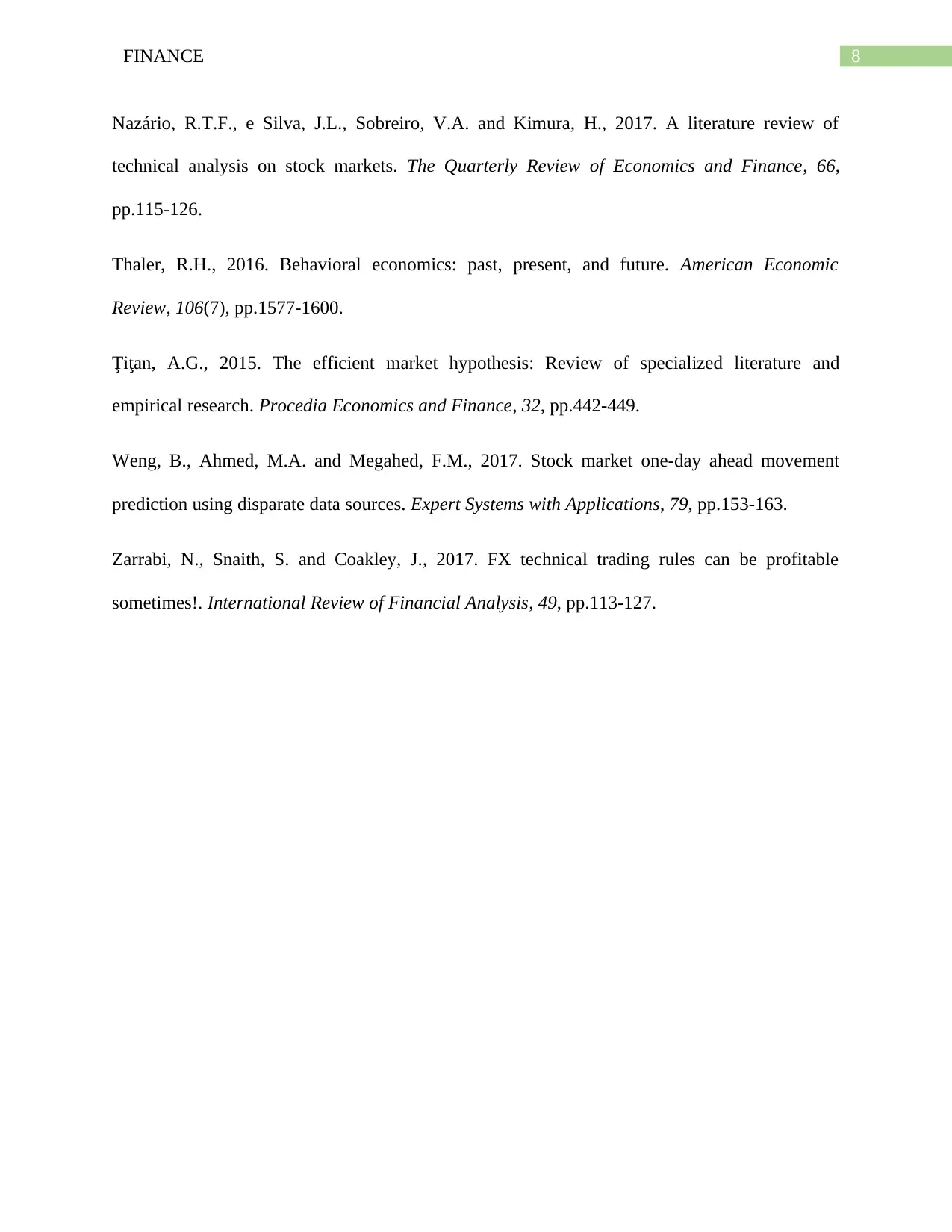
8FINANCE
Nazário, R.T.F., e Silva, J.L., Sobreiro, V.A. and Kimura, H., 2017. A literature review of
technical analysis on stock markets. The Quarterly Review of Economics and Finance, 66,
pp.115-126.
Thaler, R.H., 2016. Behavioral economics: past, present, and future. American Economic
Review, 106(7), pp.1577-1600.
Ţiţan, A.G., 2015. The efficient market hypothesis: Review of specialized literature and
empirical research. Procedia Economics and Finance, 32, pp.442-449.
Weng, B., Ahmed, M.A. and Megahed, F.M., 2017. Stock market one-day ahead movement
prediction using disparate data sources. Expert Systems with Applications, 79, pp.153-163.
Zarrabi, N., Snaith, S. and Coakley, J., 2017. FX technical trading rules can be profitable
sometimes!. International Review of Financial Analysis, 49, pp.113-127.
Nazário, R.T.F., e Silva, J.L., Sobreiro, V.A. and Kimura, H., 2017. A literature review of
technical analysis on stock markets. The Quarterly Review of Economics and Finance, 66,
pp.115-126.
Thaler, R.H., 2016. Behavioral economics: past, present, and future. American Economic
Review, 106(7), pp.1577-1600.
Ţiţan, A.G., 2015. The efficient market hypothesis: Review of specialized literature and
empirical research. Procedia Economics and Finance, 32, pp.442-449.
Weng, B., Ahmed, M.A. and Megahed, F.M., 2017. Stock market one-day ahead movement
prediction using disparate data sources. Expert Systems with Applications, 79, pp.153-163.
Zarrabi, N., Snaith, S. and Coakley, J., 2017. FX technical trading rules can be profitable
sometimes!. International Review of Financial Analysis, 49, pp.113-127.
⊘ This is a preview!⊘
Do you want full access?
Subscribe today to unlock all pages.

Trusted by 1+ million students worldwide
1 out of 9
Related Documents
Your All-in-One AI-Powered Toolkit for Academic Success.
+13062052269
info@desklib.com
Available 24*7 on WhatsApp / Email
![[object Object]](/_next/static/media/star-bottom.7253800d.svg)
Unlock your academic potential
Copyright © 2020–2025 A2Z Services. All Rights Reserved. Developed and managed by ZUCOL.





